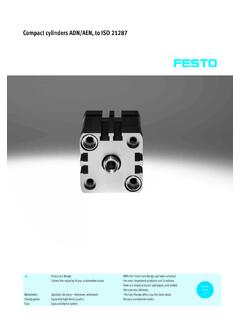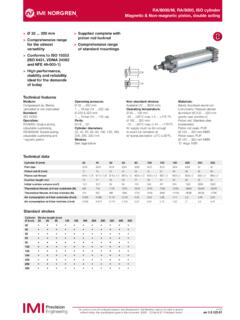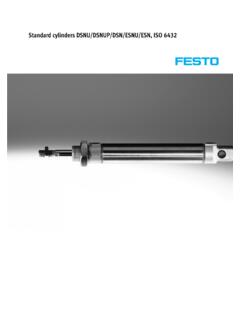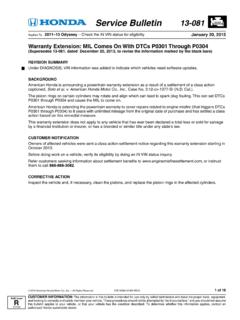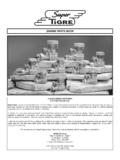Transcription of Piston Diagnosis – A rough Guide
1 1 | P a g e Piston Diagnosis The process of examining used pistons can tell us a lot of helpful information on the condition of an engine. When engine failure does occur the piexamination of it frequently helps us trace the sourccaused the failure. This article serves as a Guide for the most common mechanical problems we've seen over the years that plague you require an engine rebuild due to failure then please supply the that we are able to more accurately diagnose the cause of the failure and take appropriate action to prevent it reoccurring. Generally well set up Piston Diagnosis A rough Guide The process of examining used pistons can tell us a lot of helpful information on the condition of an engine. When engine failure does occur the Piston is likely to take most of the damage. Careful examination of it frequently helps us trace the source of the mechanical or tuning problem that's article serves as a Guide for the most common mechanical problems we've seen over the years that plague engines.
2 If you require an engine rebuild due to failure then please supply the damaged pistons as well so that we are able to more accurately diagnose the cause of the failure and take appropriate action to The crown of the Piston shows an ideal carbon deposit pattern. The transfer ports on the engine are flowing evenly and the carbon deposits are a dark chocolate brown colour. This indicates that the bike's engine has been set up and jetted correctly. The process of examining used pistons can tell us a lot of helpful information on the condition of an of the damage. Careful e of the mechanical or tuning problem that's article serves as a Guide for the most common mechanical problems we've pistons as well so that we are able to more accurately diagnose the cause of the failure and take appropriate action to The crown of the Piston shows an ideal carbon deposit pattern. The transfer ports on the engine are flowing evenly and the carbon deposits are a dark ocolate brown colour.
3 This indicates that the bike's engine has been set up and jetted correctly. 2 | P a g e Black spot Symptom - Underside of the Piston has a dark black spot. Cause - The black spot is a carbon deposit caused by oil burning onto the underside of the Piston because the crown was too hot. Reason - Main reasons for this occurring are overheating due the carbs being jetted too lean, or maybe coolant system failure. Ash Symptom - Piston crown is a light grey ash colour. Cause - This is caused by the engine running too hot. The ash colour is actually Piston material that has started to flash melt and turned to tiny flakes. If the engine was left to run much longer it would probably have developed a hot spot and hole on the exhaust port side and then finally failed. Reason - Main causes are general overheating, the bike being jetted too lean, ignition timing being too far advanced from standard, too much compression for the fuel octane being used Scoring and debris marks.
4 Debris Marks Symptom - The Piston crown and cylinder head show signs of damage where material has been crushed between the two surfaces after entering the combustion chamber. Cause - Most common causes are broken bearings in the big or small end of the con rod, broken rings and dislodged ring centering pins. Reason - Failure to adhere to manufacturers specified service intervals, incorrectly fitted rings, incorrect parts fitted. When this does occur it's extremely important to diagnose the exact cause and trace where the debris has originated from. Crankcases must be stripped and 3 | P a g e flushed to remove any remaining debris that could cause the same problem. If the cause was big end failure then the crank must be replaced along with the main bearings and seals. Chipped Symptom - The Piston crown is chipped along the top ring groove. Cause - Head gasket leak. Reason - Coolant is drawn into the combustion chamber on the down-stroke of the Piston .
5 When the coolant hits the Piston crown the change in temperature makes the aluminium brittle and it eventually cracks. In extreme cases a leaking head gasket can cause erosion at the top edge of the cylinder and the corresponding area of the head. Minor leaks from the gasket or o-ring will also appear as black spots across the gasket surface. Any engine that is suffering from coolant being forced out of the radiator cap's vent tube suggests a strong indication of a head gasket leak. In most cases the top of the cylinder and the face of the cylinder head must be resurfaced when a leak occurs. 4 | P a g e Shattered Skirt Symptom - Shattered Piston skirt. Cause - Piston to cylinder clearance too large or engine over-revved. Reason - If the Piston to cylinder clearance is too large it allows the Piston to rattle inside the cylinder bore, with time the Piston develops stress fractures and eventually cracks. The Piston to cylinder clearance should be checked every time you rebuild the top end.
6 To check the clearance measure your cylinder with a bore gauge and micrometer, then measure the Piston (in the right place) and check the readings against the limits in your engine's factory service manual. Some people put a feeler gauge down the side; this is less accurate but will give you a big enough not big enough reading. Snapped rod Symptom - Broken con rod. Cause - Clearance between the rod and big end thrust washers is too large. Reason - When the big end bearing wears out the radial deflection of the con rod becomes excessive and the rod suffers from torsion vibration. This leads to breakage of the rod and catastrophic (not to mention expensive) engine damage. Less likely on floating big end engines like the RGV, however still possible. The big end clearance should be checked every time you rebuild the top end. To check the side clearance of the connecting rod, insert a between the rod and a thrust washer and check the readings against the maximum wear limits in your engine's factory service manual.
7 5 | P a g e Four corner seizure Symptom - The Piston has vertical seizure marks at four equally spaced points around the circumference. Cause - A four corner seizure is caused when the Piston expands faster than the cylinder and the clearance between the Piston and cylinder is reduced. Reason - The main reasons for this problem are too quick warm-up, too lean carb jetting (main jet), or a spark plug with too high a heat setting being used. Multi point seizure Symptom - Piston has multiple vertical seizure marks around its circumference. Cause - This occurs if mis-matched cylinders and pistons are used, or if a cylinder is replated or bored to a size too small for the Piston (that shouldn t happen if you measure!) or the Piston was heated too fast expanding quickly before the cylinder is hot enough. Reason - As soon as the engine is started and the Piston started its thermal expansion, the Piston pressed up against the cylinder walls and seized.
8 The optimum Piston to cylinder wall clearances for different types of cylinders varies, usually with bore size. For the best recommendation on the optimum clearance for your engine look to the specs that come packaged with the Piston , or consult your factory service manual. 6 | P a g e Intake side seizure Symptom - Piston has seized on the intake side Cause - There is only ever one cause of a seizure on the intake side and that is loss of lubrication Reason - Loss of lubrication is down to three things - no pre-mix or two-stroke oil due to incorrect pre-mix ratio being used or oil pump failure/blockage, separation of the fuel and pre-mix oil in the fuel tank, water passing through the air filter and down into the carbs which in turn washes the oil film off the Piston skirt. Burn out/blow hole Symptom - Hole in the Piston crown, collapsed ring grooves on the exhaust side Cause - Piston has severely overheated. As the temperature is higher on the exhaust side problems will appear there first.
9 Reason - Air leak on the magneto side of the crankshaft seal, too lean carb jetting, ignition timing advanced too far or faulty ignition box, too hot of a spark plug range being used, too high of a compression ratio, or too low octane fuel. 7 | P a g e Blow by Symptom - Deposit on Piston skirts Cause - Piston rings worn past the maximum ring end gap spec, glazed cylinder walls Reason - This is the most common problem we see. If the rings are worn past the maximum specification they allow combustion chamber gases to seep past the rings and down the Piston skirt causing a distinct deposit pattern. If the cylinder walls are glazed or too far worn the same thing will happen and even fitting new rings will not provide a good enough seal. If in doubt you should send your cylinders to The Tuning Works for inspection and or reconditioning to obtain best performance.
